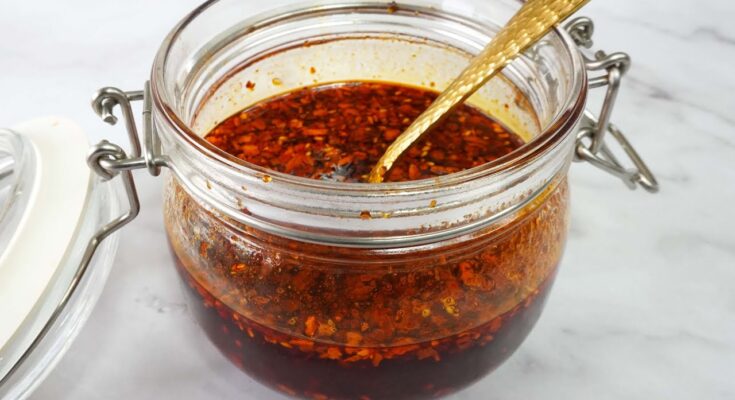Chili Oil Recipe: Chili oil is a game-changer in many kitchens worldwide. This fiery, flavorful oil can elevate a simple bowl of noodles, add depth to soups, or even become a go-to dipping sauce for dumplings. It’s a favorite in Asian, Mediterranean, and even Mexican cuisines, offering a balance of heat, aroma, and richness.
Making it at home isn’t just simple—it also allows you to customize the heat level and flavor to your liking. Whether you’re a spice lover or just a flavor enthusiast, this guide will show you how to craft your perfect batch of chili oil.
Ingredients Needed for Homemade Chili Oil
For a basic chili oil recipe, you’ll need the following:
Core Ingredients:
- 1 cup of neutral oil (like canola, vegetable, or grapeseed oil)
- 1/2 cup of dried red chili flakes
- 1 tablespoon of Sichuan peppercorns (optional for a numbing spice)
- 2 cloves of garlic (sliced thinly)
- 1-inch piece of fresh ginger (sliced)
Optional Add-ons:
- A pinch of sugar to balance the heat
- Star anise, cinnamon sticks, or bay leaves for added aroma
- Sesame seeds for texture
Each ingredient plays a role in building the flavor profile. The chili flakes provide the main heat, while garlic and ginger offer aromatic undertones. Sichuan peppercorns add a unique numbing sensation that is popular in Chinese cuisine.
Equipment and Tools You’ll Need
Having the right tools will make the process smoother and safer:
- Medium saucepan or wok (for heating the oil)
- Heat-resistant bowl (for mixing the oil and chili flakes)
- Metal strainer (optional, for removing aromatics)
- Glass jar or airtight container (for storing the oil)
- Heatproof spoon (for stirring)
Don’t have all these tools? No worries! You can improvise with common kitchen items like a regular pot and a clean mason jar.
Choosing the Right Type of Chili Peppers
The type of chili you use will define your oil’s heat and flavor. Here are a few popular choices:
- Dried red chili flakes: Commonly used for moderate heat and bright red color
- Sichuan peppers: Great for adding a numbing effect
- Kashmiri chilies: Perfect for vibrant color with less heat
- Bird’s eye chilies: Ideal for those who want intense heat
Consider your spice tolerance and the cuisine you’ll use the oil with. For a balanced kick, a blend of chili flakes and Sichuan peppercorns works beautifully.
Preparing the Ingredients
Proper preparation sets you up for success:
- Measure your chili flakes and set them aside in a heatproof bowl.
- Slice the garlic and ginger thinly to maximize surface area for infusion.
- Gather your optional spices and have them ready near the stove.
- Ensure your oil is at room temperature before starting. This helps maintain even heating.
When prepping, avoid crushing the chilies into powder unless you prefer a thicker, almost paste-like chili oil.
Heating the Oil Safely
Here’s where things heat up—literally! Proper oil temperature is crucial:
- Pour the oil into a saucepan and set the heat to medium-low.
- Add your sliced garlic, ginger, and any optional spices (like star anise).
- Let the oil heat gradually for 5–10 minutes. You’ll know it’s ready when the garlic turns golden brown.
Avoid overheating, as this can burn the aromatics and create a bitter taste. Use a thermometer if needed—aim for 275–300°F (135–150°C).
Infusing Aromatics
Once your oil is hot, it’s time to infuse flavor:
- Remove the garlic and ginger from the oil using a strainer or slotted spoon.
- Carefully pour the hot oil over the chili flakes in your heatproof bowl.
- Add Sichuan peppercorns or sesame seeds if using.
You’ll hear a satisfying sizzle as the oil blooms the spices. This step enhances the aroma and deepens the flavor.
Combining Oil and Chili Peppers
Here’s where the magic happens:
- Pour the oil in small batches to control the sizzle and prevent burning.
- Stir the mixture immediately to distribute heat evenly.
- Allow the chili flakes to steep in the oil for at least 15 minutes as it cools.
This step is essential for drawing out the chilies’ vibrant color and smoky notes.
Cooling and Storing the Chili Oil
Once the chili oil has cooled down to room temperature, it’s time to store it properly. Storing the oil correctly will preserve its flavor and extend its shelf life. Here’s what you need to do:
- Cool completely: Allow the oil to cool for at least 30–45 minutes to ensure it doesn’t cause condensation in the jar, which can lead to spoilage.
- Transfer to an airtight container: Use a clean, dry glass jar with a secure lid to prevent air exposure. Mason jars work well for this purpose.
- Label and date: For convenience, label your jar with the preparation date to keep track of its freshness.
- Store in a cool, dark place: You can store chili oil at room temperature for up to one month or refrigerate it for up to three months.
When refrigerated, the oil may solidify slightly, but it will return to a liquid state at room temperature. Always use a clean spoon to scoop out chili oil to avoid contamination.
Adjusting Spice Levels and Flavor
Making chili oil is highly customizable, so feel free to adjust the flavor to your liking. Here’s how you can tailor the spice level and overall taste:
- Reduce the heat: Use fewer chili flakes or opt for milder varieties like Kashmiri or Anaheim chilies.
- Increase the heat: Add more chili flakes or include extra-hot chilies like bird’s eye or Thai chilies.
- Add sweetness: A pinch of sugar can balance intense heat, especially if the oil tastes slightly bitter.
- Enhance with herbs: Add dried herbs like oregano or rosemary for a Mediterranean twist.
Experiment with small batches until you find your perfect balance of heat and flavor. Taste-testing as you go will help you refine the recipe to match your palate.
Health Benefits and Safety Precautions
Chili oil isn’t just delicious—it can offer some surprising health perks. However, it’s also important to handle hot oil and chili safely to prevent accidents.
Health Benefits:
- Boosts metabolism: Capsaicin, the compound that gives chilies their heat, can increase metabolism and aid in weight management.
- Improves digestion: Spicy foods can stimulate digestion and enhance nutrient absorption.
- Rich in antioxidants: Chili peppers contain vitamins A and C, which help reduce inflammation and protect cells from damage.
Safety Tips:
- Handle hot oil carefully: Always use heat-resistant tools and be cautious when pouring hot oil to avoid burns.
- Wear gloves: If handling large amounts of chili peppers, gloves can protect your skin from irritation.
- Avoid eye contact: Be mindful not to touch your eyes or face after handling chili.
With proper care, you can enjoy the full benefits of homemade chili oil while staying safe in the kitchen.
Creative Uses for Chili Oil
Chili oil is more versatile than you might think. Here are some creative ways to incorporate it into your meals:
- Drizzle over noodles: Whether it’s ramen, spaghetti, or stir-fried lo mein, chili oil adds a burst of heat and richness.
- Enhance soups: Add a spoonful to broths or stews for an extra layer of depth and spice.
- Dip for dumplings: It’s a perfect match for dumplings, spring rolls, or potstickers when mixed with soy sauce and vinegar.
- Upgrade your eggs: Drizzle chili oil over scrambled eggs or fried eggs for a spicy breakfast twist.
- Use in dressings: Combine with sesame oil, lime juice, and honey to create a spicy-sweet salad dressing.
Once you start experimenting, you’ll find endless ways to incorporate chili oil into your favorite dishes.
Custom Variations of Chili Oil
Want to make your chili oil unique? Try these variations to match different cuisines or flavor preferences:
Asian-Style Chili Oil:
- Add soy sauce, sesame oil, and green onions for a classic Chinese-inspired oil.
Mexican-Style Chili Oil:
- Use chipotle or ancho chilies and add cumin, coriander, and oregano for a smoky, earthy profile.
Mediterranean-Style Chili Oil:
- Infuse the oil with garlic, rosemary, and crushed red pepper for a versatile condiment to use with pasta and grilled vegetables.
Sweet and Spicy Fusion:
- Add a touch of honey or brown sugar for a sweet and spicy combo that’s perfect for chicken wings or roasted vegetables.
The possibilities are endless, so feel free to mix and match ingredients based on your preferences.
Common Mistakes to Avoid
Even simple recipes can go wrong without the right techniques. Avoid these common mistakes when making chili oil:
- Overheating the oil: If the oil is too hot, it will burn the chili flakes and aromatics, creating a bitter taste. Keep the temperature between 275–300°F (135–150°C).
- Burning the aromatics: Remove garlic, ginger, and other solid ingredients before they darken too much to avoid a harsh, unpleasant flavor.
- Using the wrong oil: Strongly flavored oils (like olive oil) can overpower the chili flavor. Stick to neutral oils like canola, vegetable, or grapeseed oil.
- Neglecting storage: Improper storage can lead to rancidity. Always use clean jars and store your chili oil away from light and heat.
By following these tips, you’ll create a perfectly balanced, flavorful chili oil every time.
FAQs about Chili Oil Recipe
What type of oil is best for making chili oil?
The best oils for making chili oil are neutral in flavor, such as vegetable oil, canola oil, or peanut oil. These oils allow the fiery taste of the chili to shine through without adding any unwanted flavors.
How long can I store homemade chili oil?
Homemade chili oil can be stored in an airtight container in a cool, dark place for up to 6 months. Always use a clean spoon to prevent contamination and extend its shelf life.
Can I use fresh chilies instead of dried to make chili oil?
While dried chilies are traditionally used due to their concentrated flavor and heat, fresh chilies can also be used. However, the oil’s shelf life may be shorter, and the flavor could differ significantly.
What can I use chili oil for?
Chili oil is incredibly versatile and can be used to add a spicy kick to noodles, dumplings, salads, pizzas, and more. It’s also great as a marinade for meats or a flavorful addition to your favorite dips.
Is it necessary to heat the oil before adding the chili flakes?
Heating the oil helps to release the flavors and heat from the chili flakes, creating a more potent and integrated oil. However, be careful not to overheat the oil as it can burn the chili flakes, leading to a bitter taste.
Conclusion
Making chili oil at home is a rewarding experience that allows you to control both the spice level and flavor profile. With just a few simple ingredients and careful preparation, you can create a versatile condiment that elevates your everyday meals. From noodle bowls to salad dressings, chili oil adds a bold, flavorful kick that will keep you coming back for more. So why not give it a try and customize your own signature blend?



